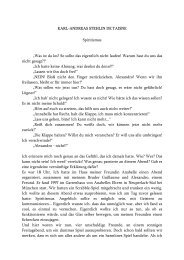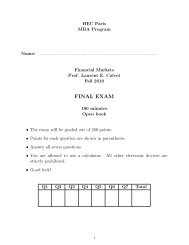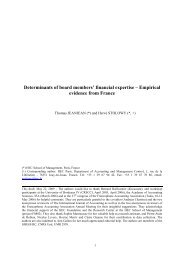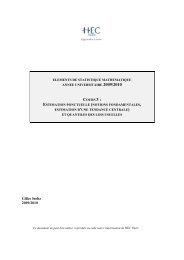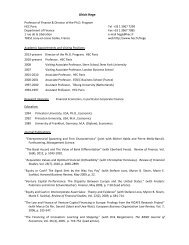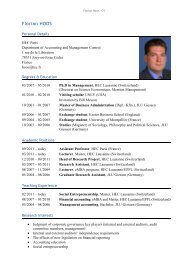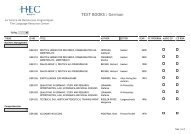Multifractality of US Dollar/Deutsche Mark Exchange Rates - Studies2
Multifractality of US Dollar/Deutsche Mark Exchange Rates - Studies2
Multifractality of US Dollar/Deutsche Mark Exchange Rates - Studies2
You also want an ePaper? Increase the reach of your titles
YUMPU automatically turns print PDFs into web optimized ePapers that Google loves.
This last figure is a vignette, reproduced at a scale that will not overemphasize its importance.<br />
The irregularities in the partition function should not be viewed simply as failures <strong>of</strong> the model, but<br />
as opportunities to learn about different types <strong>of</strong> behavior and their causes. Comparing the JPY/<br />
<strong>US</strong>D series in levels with the DM/<strong>US</strong>D series, JPY/ <strong>US</strong>D appears much smoother, particularly<br />
lacking in sharp local peaks. Institutional differences may matter.<br />
On this point, a recent study <strong>of</strong> concerted interventions by G-3 Central banks finds almost twice<br />
the dollar value <strong>of</strong> intervention in the JPY/ <strong>US</strong>D market as in the significantly larger DM/<strong>US</strong>D<br />
market. 43 While the connection between activism in exchange rate policies and scaling behavior<br />
has not been empirically established, it seems reasonable that the institutional rules or customs<br />
that govern a market affect the appearance <strong>of</strong> its price series. In turn, this may give a distinctive<br />
signature to partition functions or multifractal spectra. Comprehensive study <strong>of</strong> other data sets is<br />
the first step in studying this relationship.<br />
More fundamentally, the MMAR does not exhaust the set <strong>of</strong> possible scaling models. While the<br />
JPY/ <strong>US</strong>D series does not appear entirely consistent with the MMAR, no completely satisfactory<br />
alternative is apparent. 44 Scaling models may be modified in the future to describe a greater variety<br />
<strong>of</strong> behavior.<br />
8 Conclusion<br />
This paper has conducted the first empirical investigation <strong>of</strong> a multifractal model in economics.<br />
Consistent with the Multifractal Model <strong>of</strong> Asset Returns, we find evidence <strong>of</strong> a multifractal scaling<br />
law in an important financial data set, <strong>Deutsche</strong>mark / <strong>US</strong> <strong>Dollar</strong> returns. The scaling properties<br />
<strong>of</strong> the data set are robust to variations in data reporting, including use <strong>of</strong> bids, asks, or averages<br />
as approximations to price; use <strong>of</strong> market price quotes or government reported exchange rates;<br />
and treatment <strong>of</strong> missing values. The DM/<strong>US</strong>D scaling properties are also robust to seasonal<br />
adjustment methods. Further, within subsamples <strong>of</strong> the data, the scaling laws are quite similar.<br />
We thus propose that a single, stationary model can provide a good approximation to the generating<br />
process <strong>of</strong> the data, covering not only a long and highly variable sample span (1973-1997), but also<br />
43 Catte, et al. (1994) studies a sample <strong>of</strong> nineteen major concerted interventions from 1985-1991. <strong>Dollar</strong> interventions<br />
were about $100 billion for JPY/<strong>US</strong>D vs. about $54 billion for DM/<strong>US</strong>D.<br />
44 The JPY/<strong>US</strong>D first differences are quite different from the FIGARCH simulations, the most obvious difference<br />
being the lack <strong>of</strong> variation in volatility at high frequencies in FIGARCH.<br />
31



